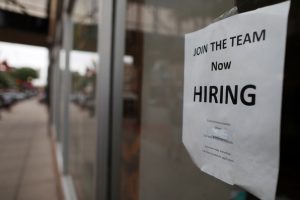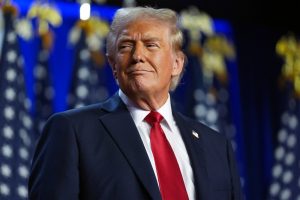
Real World Economics: Donald Trump’s ambitious agenda would affect all of us for years to come
Edward Lotterman
Few things in life happen immediately. Moreover, the more complicated a “thing” is, the longer the lapse in time before all consequences play out. President-elect Donald Trump put two enormously important elements at the center of his ambitious agenda for economic change. Don’t expect either to be anywhere near complete before several years have passed.
The first of these is to revamp U.S. federal finances more completely than at any time in the last 236 years. Trump wants to move from a core concentration on personal and corporate income taxes to one on taxes on imports. Those coming from China will be taxed at 60% of value under his plan. Anyone importing from the rest of the world will have to pony up 10% or 20%. These would be the highest levels in at least 90 years for some.
The second initiative, one more important, in terms of probable social and economic upheaval, is Trump’s plan for forcible expulsions of all illegal immigrants. He promises a crash program starting right after his inauguration. If this is carried out, this might form the largest mass movement of people in 80 years. It will rival turbulent forced migrations in the wake of World War II some 80 years ago. If Trump is serious, expect a gigantic effort requiring enormous human, physical and financial resources.
Even if higher tariffs or immigrant expulsions start immediately, say in one month or six, several years will pass before the full effects of either initiative are fully incorporated in our nation’s economy. That they have in common.
The promised actions do differ, however, in very key ways.
A tariff increase, even a large one, could be administratively implemented quite quickly, much of it in a matter of months. We already do charge tariffs on some imports. These include certain merchandise that we have long taxed, but at very low rates in recent decades following cuts in rounds of trade negotiations since 1947. New ones levied by Trump on Chinese and Canadian products via administrative order were left in place by President Joe Biden.
(For an excellent but blandly neutral overview of tariffs, search for “What are tariffs?” on the site of the long-respected Council on Foreign Relations.)
Thus existing federal agencies and their detailed agency rules, procedures and structures along with appeal and enforcement mechanisms are “going concerns” in accounting terminology. Simply changing tariff rates has been done before. So much of the federal government’s implementation could be done in months. Understand that constitutionally this requires congressional action, but there are loopholes that Trump might again use.
Regardless of how swiftly higher charges on imports can be put into effect, years will pass for increased costs of goods to work fully their way through the economy. Every business and household in our nation will have to alter how they spend money and how they earn it. There will be chains of ensuing changes, like one slowly toppling domino after another.
Importers frantically will seek goods from other nations than China. These alternative exporters will see both prices they can charge and volumes they can sell rise despite the 10% or 20% their own shipments get hit with.
Still operating U.S. producers, if any, will see orders burgeon. But they will need more workers and raw materials plus larger factories with more machines. Wages paid will need to rise. Constructing new distribution chains will be vital. Such flows of resources into new import-substituting sectors will compete with labor, machinery and materials already going to other uses. Market prices of all these factors will have to adjust to such shifts in supply and demand. All of this will develop over years if not decades.
Facing sharp rises in costs of imported merchandise, households will adjust spending. The planned upgrade from a still serviceable TV set to larger and flashier one may be dropped, but some money saved may go to a ski weekend. Cars will be driven for an additional year or two or three, but mechanics will get more business for repairs and overhauls. Sewing repairs and alterations to apparel will again be common as for our grandparents. Perhaps boys will go to school with patched knees on their blue jeans as I often did!
All in all, actions, an adjustment process of first-round reactions and then a series of subsequent re-reactions will go on for years. Like dropping a large rock into deep, still pool in an old quarry, initial effects will ripple out, but soon bounce off one wall here and another there. Rebounding ripples will cross each other, bouncing again and again until results of the huge initial disruption dissipate.
Understand that there also will be large changes for other world economies. Also understand that tariffs on all the rest of the world, even if at lower rates than on China, will have greater effects on export sectors like farming than Trump’s first-term levies. Then, China bought more soybeans from Brazil and less here. But more U.S. production flowed to Europe because their usual buying from Brazil was costlier. That won’t be true now. U.S. farm products will face less overall export demand and producers will be hard hit.
So, high tariffs could be up and running quickly even if adjustments take years to play out.
Expelling illegal immigrants is very different. Pushing out the 12 million to 14 million immigrants tabulated by the U.S. government, or the 35 million asserted by Marco Rubio and others, will take years. Enormous amounts of human labor, facilities and equipment will be needed.
The desperate, forced resettlement of 14 million ethnic Germans after World War II teaches some lessons. Countries where they had lived, whether for a few years or generations, did not want them. Despite victorious Allies promising an “orderly and humane” relocation, for most it was a desperate scramble to avoid brutality, rape or death. A half-million did die after the war had, on paper, ended.
That violence won’t happen here. But collaring millions of people, even if only hundreds of thousands in any one year, will require tens of thousands of agents, perhaps equivalent to a new Marine Corps, thousands of buses, barracks or tents plus guards, cooks, medics and doctors. Habeas corpus will still stand; hearings to separate citizens or others here legally will have to take place.
Much, much more could be said. The faster the expulsions take place, the more extreme the adjustments forced on meat packers, poultry processors, dairy farmers, construction contractors, hotels and hospitals. Even employers careful that all their employees are here legally will bear increases in wage rates due to a lower labor supply. Wage rates for millions will rise as will costs for new houses or gallons of milk.
Other details await future discussions. The core fact, however, is that both high import tariffs and the expulsion of 3 percent or more of our population will impose large dead-weight losses affecting all of us. These are costs to some persons that are not offset by gains to others. Society as a whole ends up worse off, with fewer goods and services to meet human needs produced from the same level of resources expended.
St. Paul economist and writer Edward Lotterman can be reached at stpaul@edlotterman.com.


